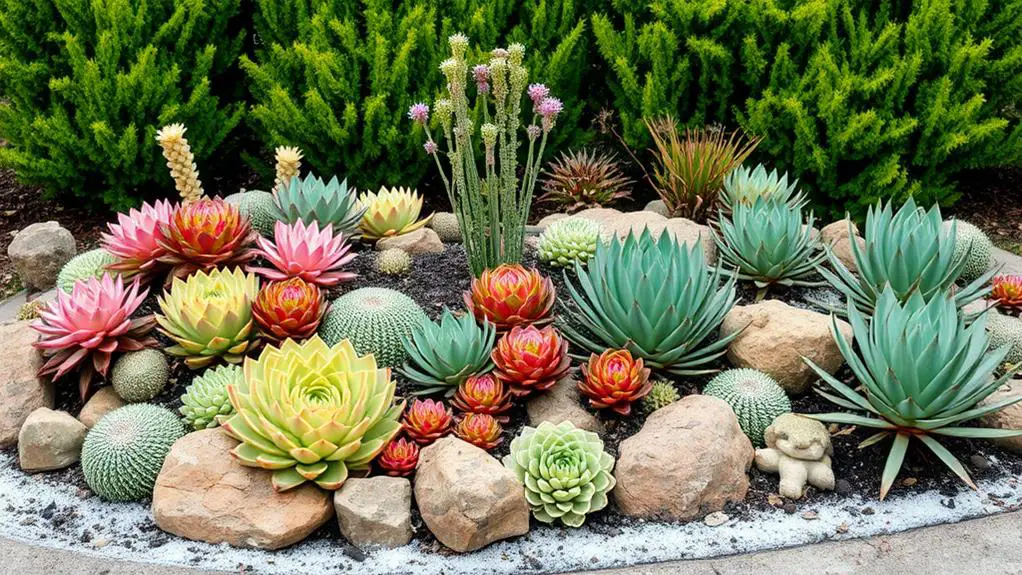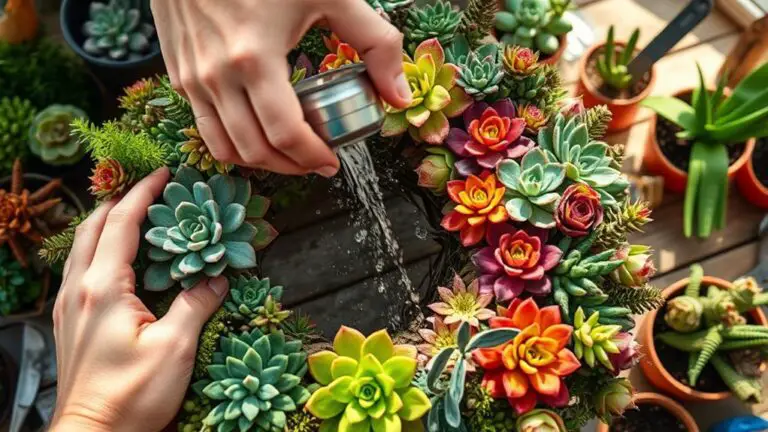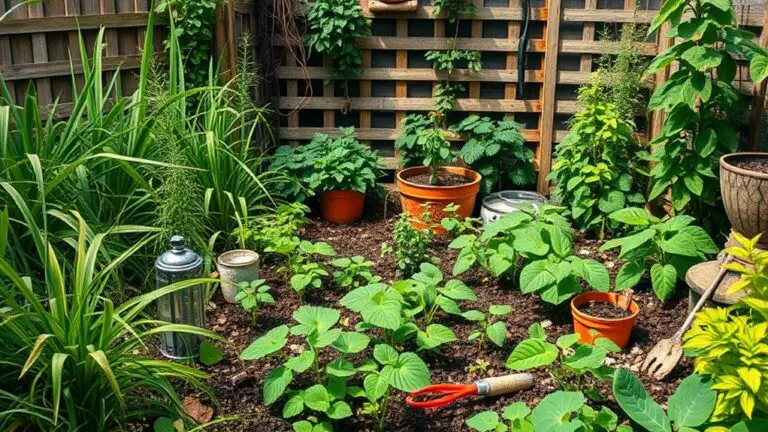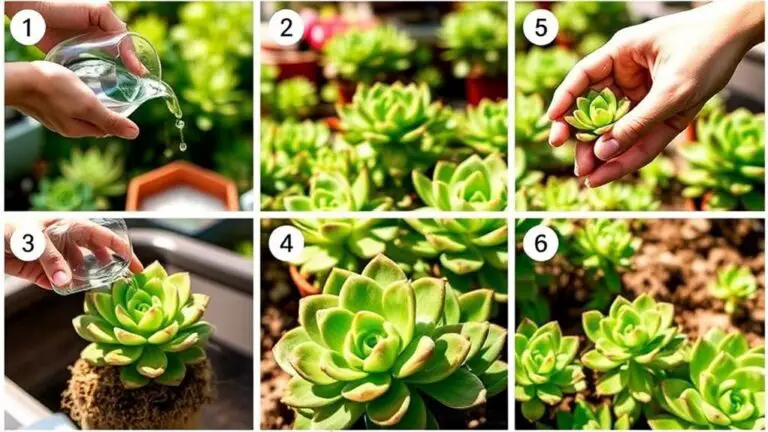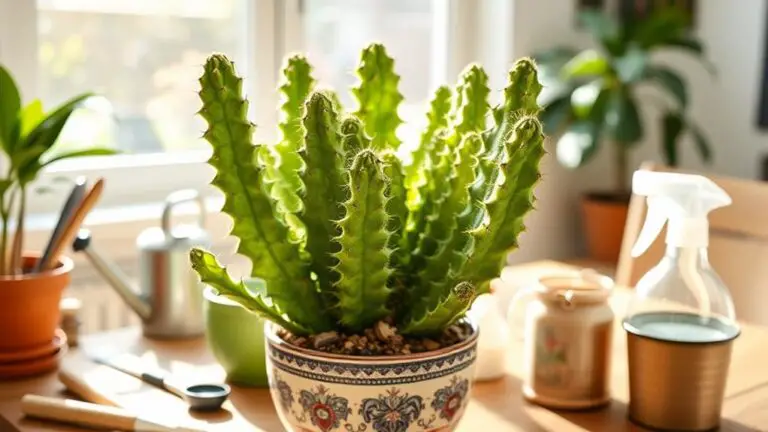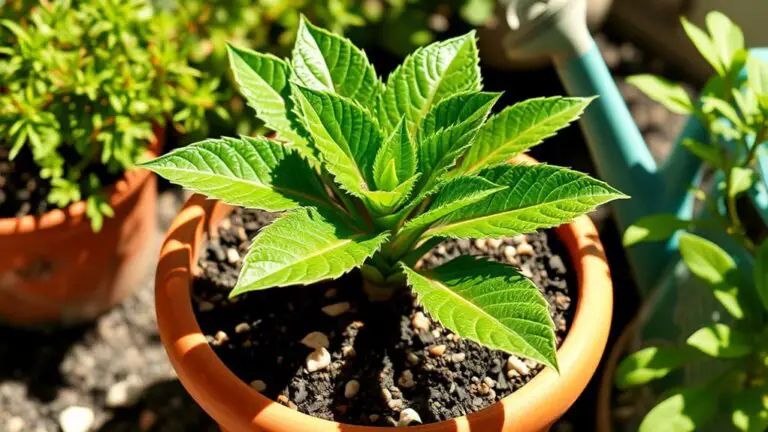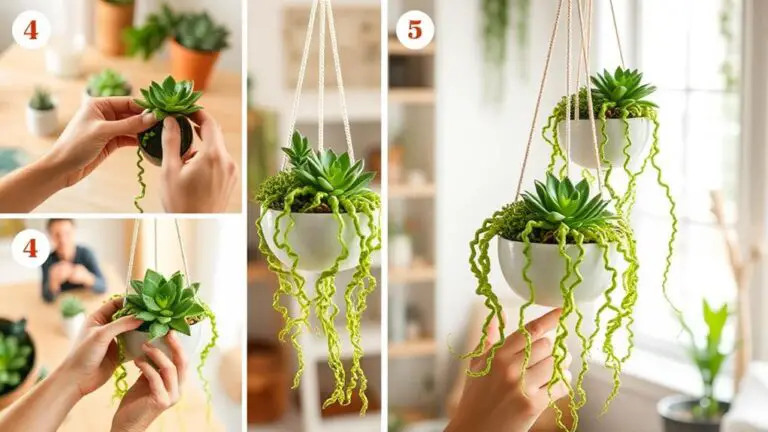Cold Hardy Succulents for Building a Resilient Outdoor Garden
If you're aiming to create a resilient outdoor garden that thrives even in harsh winter conditions, cold hardy succulents might be the perfect solution. Varieties like Sempervivum and Sedum spurium not only survive but flourish in temperatures as low as -30°F. These succulents bring vibrant colors and unique textures to your landscape while demanding minimal maintenance. But how do you guarantee these plants integrate seamlessly into your garden design and meet their specific soil and watering needs? Let's explore the practical steps you need to take to achieve a sustainable, beautiful garden year-round.
Cold Hardy Succulent Varieties
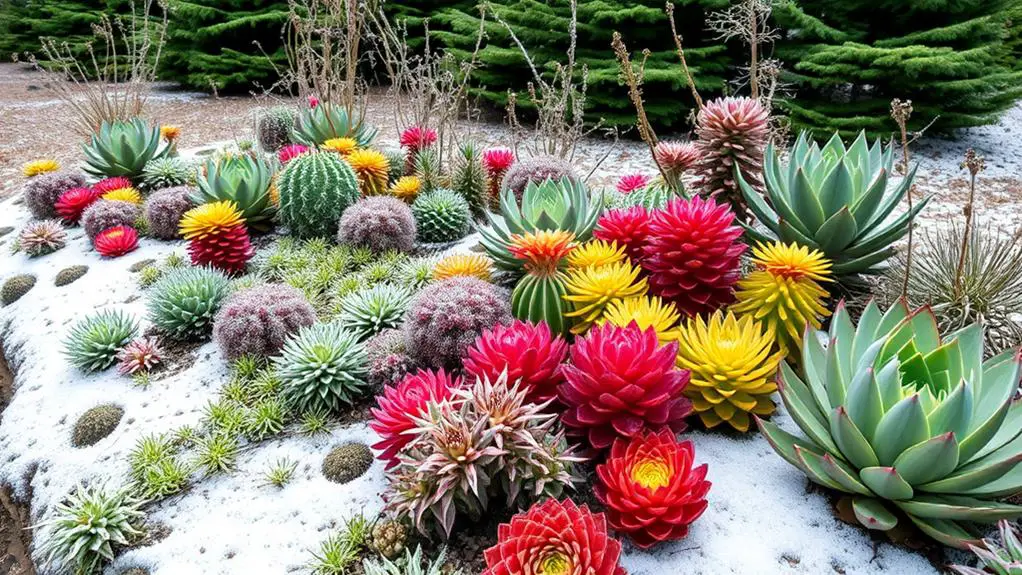
When planning an outdoor garden in a colder climate, you'll want to contemplate cold hardy succulents that can endure harsh winter conditions. These resilient plants will add beauty and texture to your garden all year round.
Consider hardy succulents like Sempervivum varieties, which can withstand temperatures as low as -30°F (-34°C). They're excellent for outdoor gardens due to their durability.
Another great option is Rosularia platyphylla, known for its exceptional resilience down to -20.02°F (-28.9°C). It works well as ground cover or even in wall planting, giving you flexibility in your garden design.
Sedum spurium is another cold hardy succulent that thrives in extreme cold, enduring down to -30°F (-34°C). It forms dense mats of foliage and produces vibrant red flowers in summer, adding a splash of color to your garden.
For a plant with a unique look, try Sempervivum arachnoideum. It has a spider web-like appearance and thrives in frost-prone climates, hardy to 14°F (-10°C).
Lastly, Pachyveria pachytoides is known for its chubby appearance and can survive harsh outdoor conditions year-round, with cold hardiness to 14°F (-10°C).
These succulent varieties will guarantee your garden remains vibrant and resilient, no matter the weather.
Unique Succulent Features
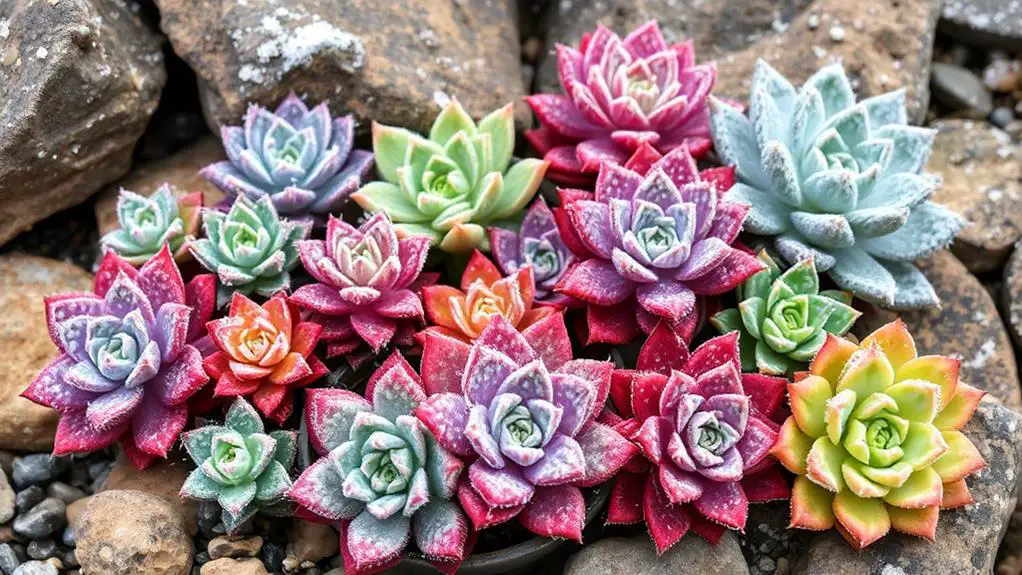
Unique succulent features can turn your garden into a visual masterpiece, thanks to their distinct shapes, colors, and textures. Cold-hardy succulents like the Queen Victoria Agave and Ice Plant Oscularia Deltoides offer striking geometric leaves and trailing growth forms, respectively.
The Queen Victoria Agave impresses with its architectural leaves and tall flower spike after several years, enduring temperatures as low as 41°F (5°C). Similarly, the Ice Plant Oscularia Deltoides adds a splash of color, turning pink or red in sunlight and blooming with purple flowers in spring.
The Variegated Butterfly Agave, another cold-hardy succulent, displays an attractive rosette shape and creamy yellow summer blooms, hardy to 41°F (5°C).
Aloe Blue Elf stands out with its compact, upright, grey-green leaves and vibrant purple flower spikes with orange blooms, thriving in temperatures as low as 20°F (-6°C).
Don't forget the Echeveria Elegans, also known as the "Mexican Snowball," which forms plump, pale blue-green rosettes and showcases pink flowers in spring. It's cold hardy to 28°F (-2°C).
These perennial succulents bring not just resilience to your garden, but also unique and enchanting features that can thrive in cooler climates.
Resilient Succulents for Cold Regions
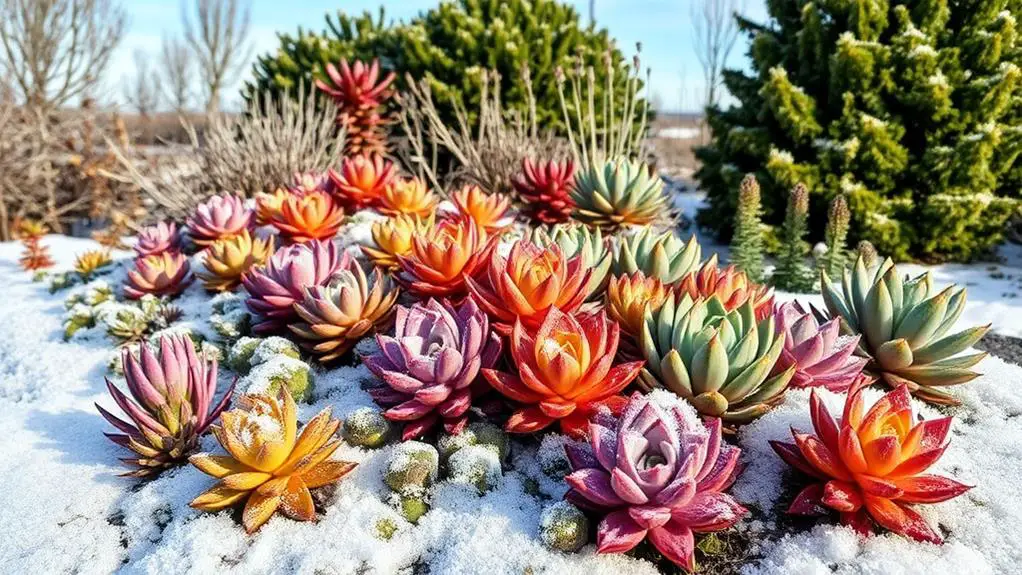
If you're looking to add some hardy plants to your garden that can endure harsh winters, resilient succulents for cold regions are a fantastic option.
These tough plants not only survive but thrive in chilly temperatures, making them perfect for your outdoor garden.
One excellent choice is Sedum Spurium. It can withstand temperatures as low as -30°F (-34°C), making it one of the most cold-hardy succulents around.
Another option is the Sempervivum varieties, also known as Hens and Chicks. These resilient plants can survive down to -4°F (-20°C) and produce side buds, adding both hardiness and beauty to your garden.
Rosularia platyphylla is another succulent that thrives in extremely cold environments, enduring temperatures as low as -20°F (-28.9°C).
It works well as a ground cover, providing both protection and visual interest. For a splash of color, consider Sedum Golden Glow, which showcases vibrant jelly-orange-red leaves and tolerates temperatures down to -22°F (-30°C).
Lastly, Graptopetalum paraguayense can handle freezing conditions as low as 5°F (-15°C).
Its adaptability to extreme temperature fluctuations makes it a reliable choice for your cold outdoor garden.
Specialized Succulent Care
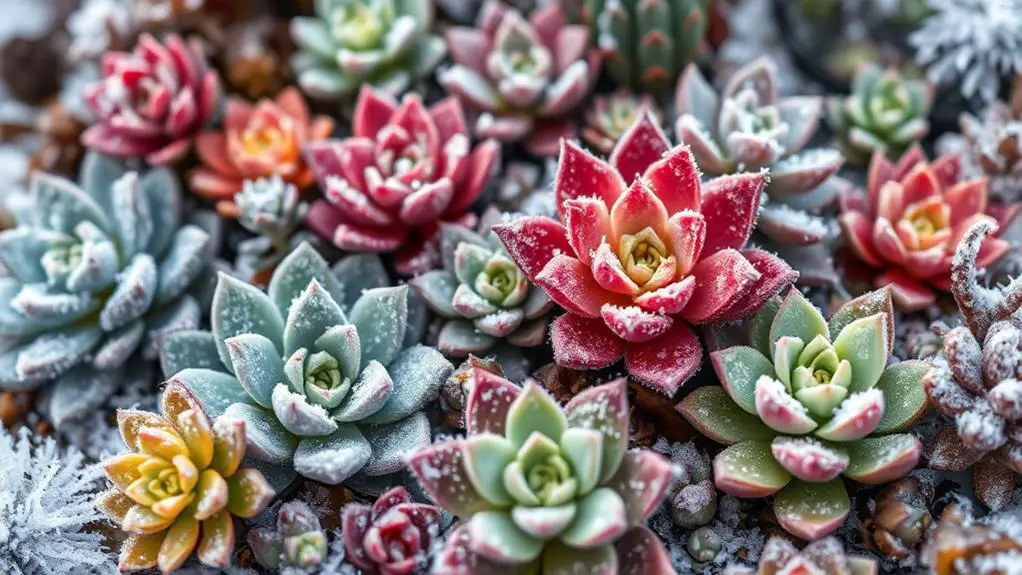
To keep your cold hardy succulents like Sempervivum and Sedum healthy, it's essential to focus on well-draining soil to prevent root rot, especially during wet winter months.
Reduce watering to just 1-2 times a month in the winter, since these plants enter dormancy and need less moisture.
Pay attention to seasonal changes, adjusting care as needed, such as providing afternoon shade during hot summers to avoid sunburn.
Well-Draining Soil Importance
When caring for cold hardy succulents, well-draining soil is absolutely crucial. This type of soil prevents root rot by letting excess moisture escape, which is especially important during the winter months when your plants are more prone to overwatering.
Cold hardy succulents thrive in soil that can maintain ideal moisture levels without staying soggy. To guarantee your succulents are happy, consider using a cactus or succulent mix that includes sand or perlite. This enhances drainage and supports healthy root development.
Regular checks of soil moisture are also key; wait until the top inch of soil is dry before watering again. Incorporate organic matter like compost to improve soil structure and drainage. This also provides essential nutrients, creating a thriving environment for your plants.
- Prevents Root Rot: Well-draining soil guarantees that excess water doesn't sit around the roots, avoiding root rot.
- Enhances Drainage: Ingredients like sand or perlite in the soil mix improve drainage capabilities.
- Adds Nutrients: Organic matter, such as compost, boosts soil structure and nutrient levels.
Optimal Watering Techniques
Watering cold hardy succulents requires a specialized approach to keep them thriving. To start, you need to follow ideal watering techniques, which means deep, infrequent watering. This helps encourage strong root development.
Always let the well-draining soil dry out completely between waterings. It's vital to avoid overwatering, especially in winter, since cold hardy succulents are prone to root rot when they sit in soggy soil.
Using pots with drainage holes is a must. These holes let excess water escape, preventing waterlogging. After transplanting your succulents, wait 2-4 days before watering. This gives the roots time to callus and settle into their new environment.
Once established, adjust watering frequency based on the season. In winter, reduce it to just 1-2 times a month to avoid root rot.
Always monitor soil moisture before you water. You can stick your finger into the soil to check if it's dry a few inches down. If it's still damp, hold off on watering.
Seasonal Care Tips
Caring for cold hardy succulents through the changing seasons guarantees they remain healthy and vibrant year-round. These unique plants aren't only beautiful but also resilient, thriving in various conditions if given the right care.
During winter, practice minimal watering, only 1-2 times a month, to prevent root rot. Cold hardy succulent varieties endure freezing temperatures down to -30°F, but watch out for sudden warm spells. Quick changes can stress your plants, so protect them from frost when needed.
Here are essential seasonal care tips:
- Temperature Monitoring: Keep an eye on temperature fluctuations. Sudden warm spells might require extra frost protection.
- Dead Leaf Removal: Regularly clear out dead, dry leaves to reduce pest attraction and improve air circulation.
- Watering Adjustments: Reduce watering in fall as plants go dormant, and let the soil dry completely between waterings.
In spring and summer, your succulents enter their active growth period. Light feeding with a diluted fertilizer can enhance their growth and resilience.
Adjust your watering techniques as the seasons change. By following these tips, you'll guarantee your cold hardy succulents stay strong and lively all year long.
Soil and Watering Needs
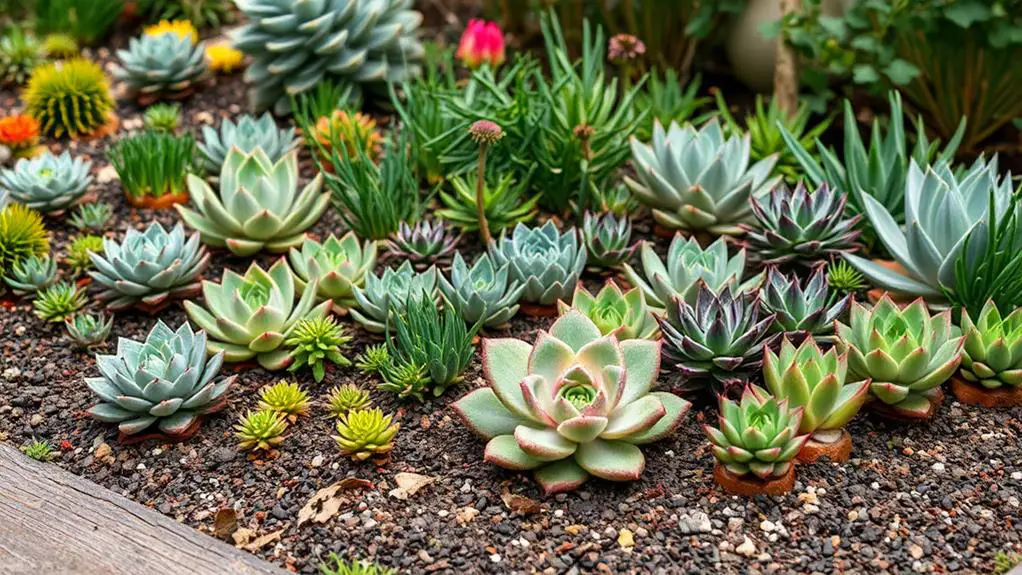
To keep your cold hardy succulents healthy, start with well-draining soil like a cactus or succulent mix to prevent root rot.
Water deeply but infrequently, letting the soil dry out completely between waterings.
During winter, cut back on watering to just once or twice a month to avoid soggy roots in cold weather.
Well-Draining Soil Essentials
Ensuring your cold hardy succulents thrive starts with providing well-draining soil, a foundation essential for preventing root rot and fostering healthy growth.
Cold hardy succulents need soil that allows excess moisture to escape easily. You'll want to use a cactus or succulent mix, which is designed for ideal drainage. This type of soil helps you avoid the dreaded root rot that can occur when succulents sit in soggy conditions.
Here are some key points to keep in mind:
- Use a cactus/succulent mix: This type of soil is specifically formulated to drain well, reducing the risk of root rot.
- Water deeply but infrequently: Allow the soil to dry out completely between watering sessions; this mimics the natural environment of succulents.
- Monitor soil moisture: Always check the soil before watering to avoid overwatering, which can harm your plants.
Proper Watering Techniques
Mastering the art of watering is essential for nurturing cold hardy succulents. These resilient plants thrive best in well-draining soil, such as a cactus or succulent mix, which prevents root rot.
When you water, make sure to water deeply but infrequently. This means soaking the soil thoroughly and then allowing it to dry out completely before watering again. Typically, you'll wait 2-4 days after transplanting to water.
It's vital to monitor soil moisture before each watering. Cold hardy succulents can handle drought better than being overwatered, which is key to their survival.
During winter months, when many varieties enter dormancy, reduce watering to just 1-2 times a month. Keeping the soil drier during this period helps prevent damage.
Garden Design Integration
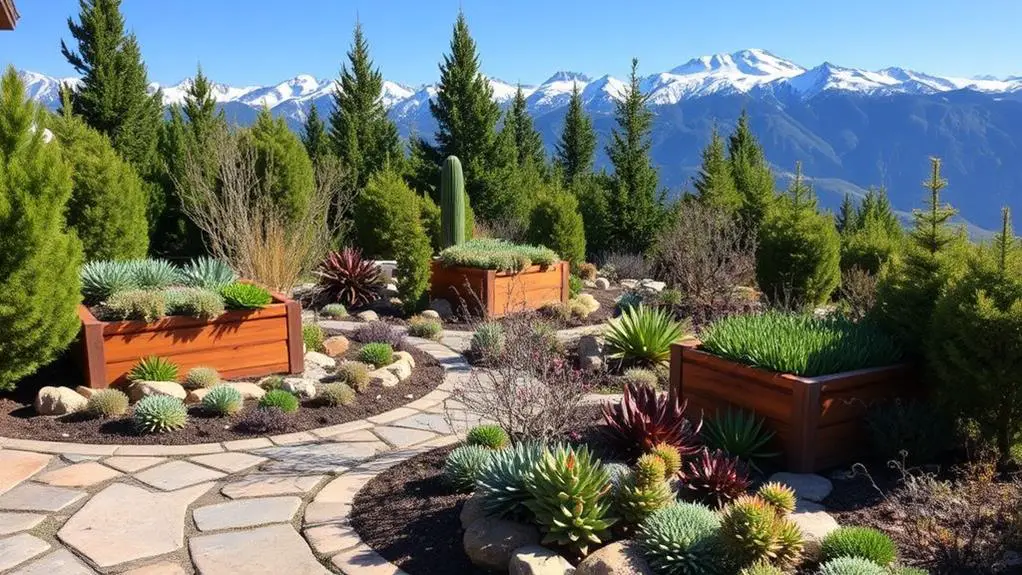
Incorporating cold hardy succulents into your garden design can transform your outdoor space into a vibrant, resilient landscape. These plants, like Sempervivum and Sedum varieties, thrive in temperatures as low as -30°F, ensuring year-round interest. To maximize their potential, consider a few key strategies.
First, use cold hardy succulents in a rock garden. This setup not only highlights their unique shapes and colors but also improves drainage, reducing the risk of root rot. Rock gardens are perfect for growing succulents that need full sun and minimal water.
Second, integrate ground cover succulents like Sedum spurium and Rosularia platyphylla to enhance textures and colors. These plants are low-maintenance and ideal for low-water landscapes, making your garden both beautiful and sustainable.
Third, create focal points with tall-growing succulents such as Agave and Echeveria. Their height and vibrant colors add depth and interest to your garden design.
- Rock gardens: Enhance drainage and highlight succulent shapes.
- Ground cover succulents: Add texture and color with minimal maintenance.
- Tall-growing succulents: Create striking focal points.
Pest Management and Monitoring
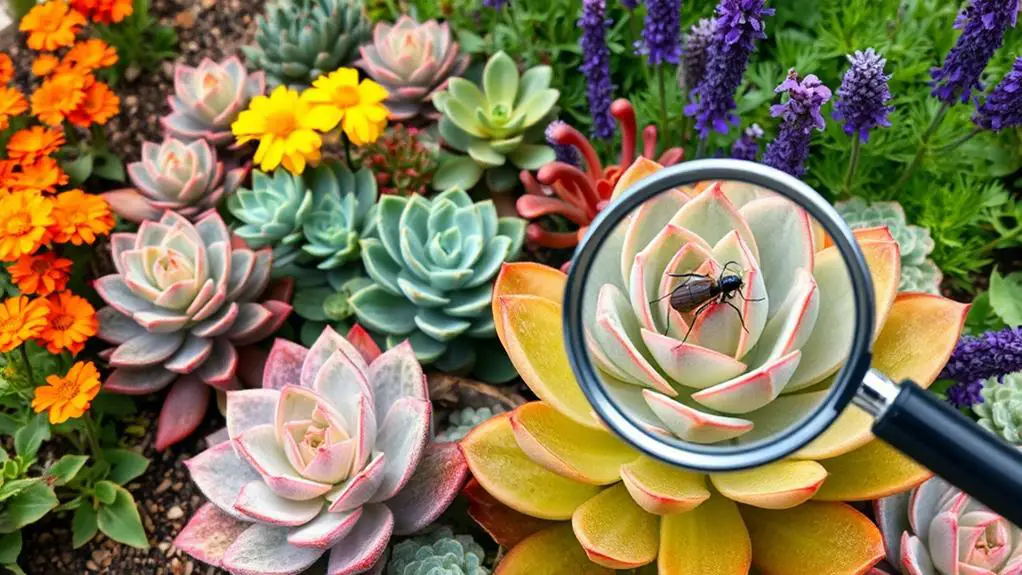
While designing your garden with cold hardy succulents, it's also important to maintain their health through effective pest management and monitoring. Regularly checking your plants is key to catching problems early. Early detection of pests can prevent infestations from spreading and causing significant damage.
Start by ensuring good air circulation around your succulents. Mold and pests thrive in humid environments, so keeping the area well-ventilated helps. Common pests to watch for include mealybugs, aphids, and spider mites. If you spot these, treat infestations promptly using insecticidal soap or neem oil.
Don't forget to remove dead or dry leaves regularly. This simple task can minimize pest attraction and help keep your succulent garden healthy.
Implementing a seasonal pest management routine is also a smart move. During active growth periods, preventive treatments can make a big difference in keeping your plants resilient.
Frequently Asked Questions
What Is the Most Resilient Succulent?
The most resilient succulent is Sedum Spurium. It withstands temperatures as low as -30°F (-34°C), making it ideal for extreme winter conditions. You'll find it perfect for creating a hardy and enduring garden in cold climates.
What Type of Succulents Can Survive Winter?
You can grow succulents like Sempervivum, Sedum, and Orostachys in your garden. They're tough enough to survive harsh winters, with some enduring temperatures as low as -30°F, making them perfect for cold climates.
What's the Lowest Temperature Succulents Can Withstand?
You'll find that some succulents can withstand temperatures as low as -30°F (-34°C). Varieties like Sempervivum and Sedum are incredibly resilient, thriving even in harsh winter climates. Always check specific tolerances for each type.
Can I Leave My Succulents Outside in the Winter?
Yes, you can leave cold hardy succulents like Sempervivum and Sedum outside in winter. Make certain they're in well-draining soil and get enough sunlight. Reduce watering and monitor snow cover for insulation against extreme cold.
Conclusion
By choosing cold hardy succulents like Sempervivum and Sedum spurium, you're setting up your garden for year-round success. These tough plants survive harsh winters and need little care, making them perfect for any gardener. Just remember to provide well-draining soil and water sparingly. Incorporate these resilient succulents into your garden design, and you'll enjoy vibrant colors and unique textures throughout the year. With a bit of planning, your garden will thrive no matter the season.

